1.线性回归概述及其简单实现

1.1 Numpy实现线性回归
1.1.1 穷举法更新参数w,模型y = w*x
传送门
import numpy as np
import matplotlib.pyplot as plt
#写入数据集
x_data = [1.0, 2.0, 3.0]
y_data = [2.0, 4.0, 6.0]
# 线性回归模型
def forward(x):
return x * w
#计算损失函数(MSE均方误差)
def loss(x, y):
y_pred = forward(x)
return (y_pred - y) ** 2
# 穷举法更新参数w
w_list = [] #用于存放更新的参数w
mse_list = []
for w in np.arange(0.0, 4.1, 0.1):
print("w=", w)
l_sum = 0 # 初始化,用于计算损失和
for x_val, y_val in zip(x_data, y_data):
y_pred_val = forward(x_val)
loss_val = loss(x_val, y_val)
l_sum += loss_val # 计算损失和
print('\t', x_val, y_val, y_pred_val, loss_val)
print('MSE=', l_sum / 3) #求均方误差
w_list.append(w) #将每一步更新的参数w存入列表w_list中,以便在后面可视化中绘制跟踪曲线
mse_list.append(l_sum / 3)
plt.plot(w_list, mse_list) #将参数w更新以及每一步计算损失函数的过程绘制出一个“跟踪曲线来”
plt.ylabel('Loss')
plt.xlabel('w')
plt.show()
代码助解:

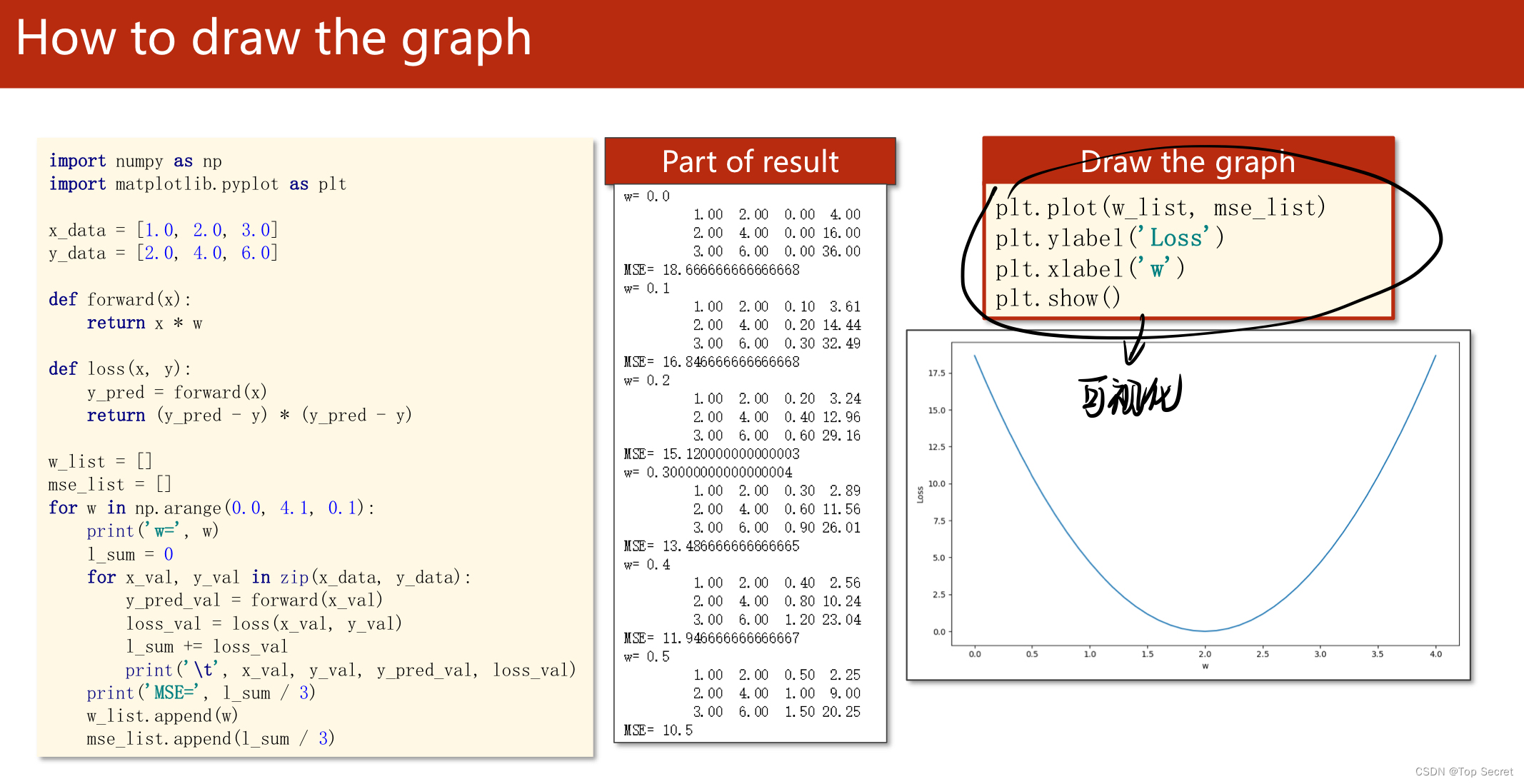
注意:
(1) 如上代码的线性模型是:y = w*x
(2) python中zip()函数的用法:
传送门
zip函数的原型为:zip([iterable, …]):
参数iterable为可迭代的对象,并且可以有多个参数。该函数返回一个以元组为元素的列表,其中第 i 个元组包含每个参数序列的第 i 个元素。返回的列表长度被截断为最短的参数序列的长度。只有一个序列参数时,它返回一个1元组的列表。没有参数时,它返回一个空的列表。
import numpy as np
a=[1,2,3,4,5]
b=(1,2,3,4,5)
c=np.arange(5)
d="zhang"
zz=zip(a,b,c,d)
print(zz)
输出:
[(1, 1, 0, 'z'), (2, 2, 1, 'h'), (3, 3, 2, 'a'), (4, 4, 3, 'n'), (5, 5, 4, 'g')]
1.1.2 模型 y = w*x + b 实战
好文传送
# 使用模型y=wx+b,并绘制三维图形
import numpy as np
import matplotlib.pyplot as plt # 绘图包
x_data = [1.0, 2.0, 3.0] # 数据集保存,x和y需分开,x为输入,y为输出
y_data = [3.0, 5.0, 7.0]
def forward(x): # 线性模型(前馈)
return x * W + B #加入偏置B
def loss(x, y): # 损失函数
y_pred = forward(x)
return (y_pred - y) * (y_pred - y)
#更新参数w,B
w = np.arange(0.0, 4.1, 0.1)
b = np.arange(0.0, 2.1, 0.1)
[W, B] = np.meshgrid(w, b) # 将w,b变为二维矩阵,将w和b变为二维矩阵后就不需要使用for循环来修改w的值
l_sum = 0
for x_val, y_val in zip(x_data, y_data):
y_pred_val = forward(x_val)
loss_val = loss(x_val, y_val)
l_sum += loss_val
print('\t', x_val, y_val, y_pred_val, loss_val)
print('MSE=', l_sum / 3)
# 此部分代码与例题完全相同,即使用forward函数计算x对应的y,用loss函数计算损失函数,MSE为平均损失函数
# 绘图:二维时使用plt.plot绘图,三维则使用matplotlib绘图
fig = plt.figure()
ax = fig.add_subplot(projection='3d')
# 引入3d绘图
ax.plot_surface(W, B, l_sum / 3) # 引入W,B,l_sum/3三个绘图参数
plt.show()
# 引入matplotlib中的三维曲面图
输出:
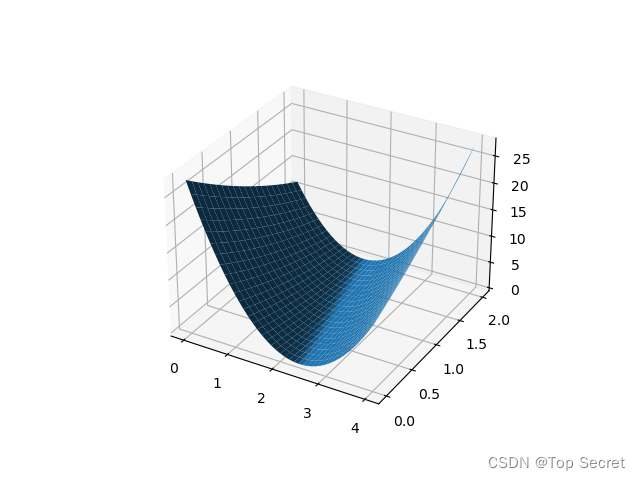
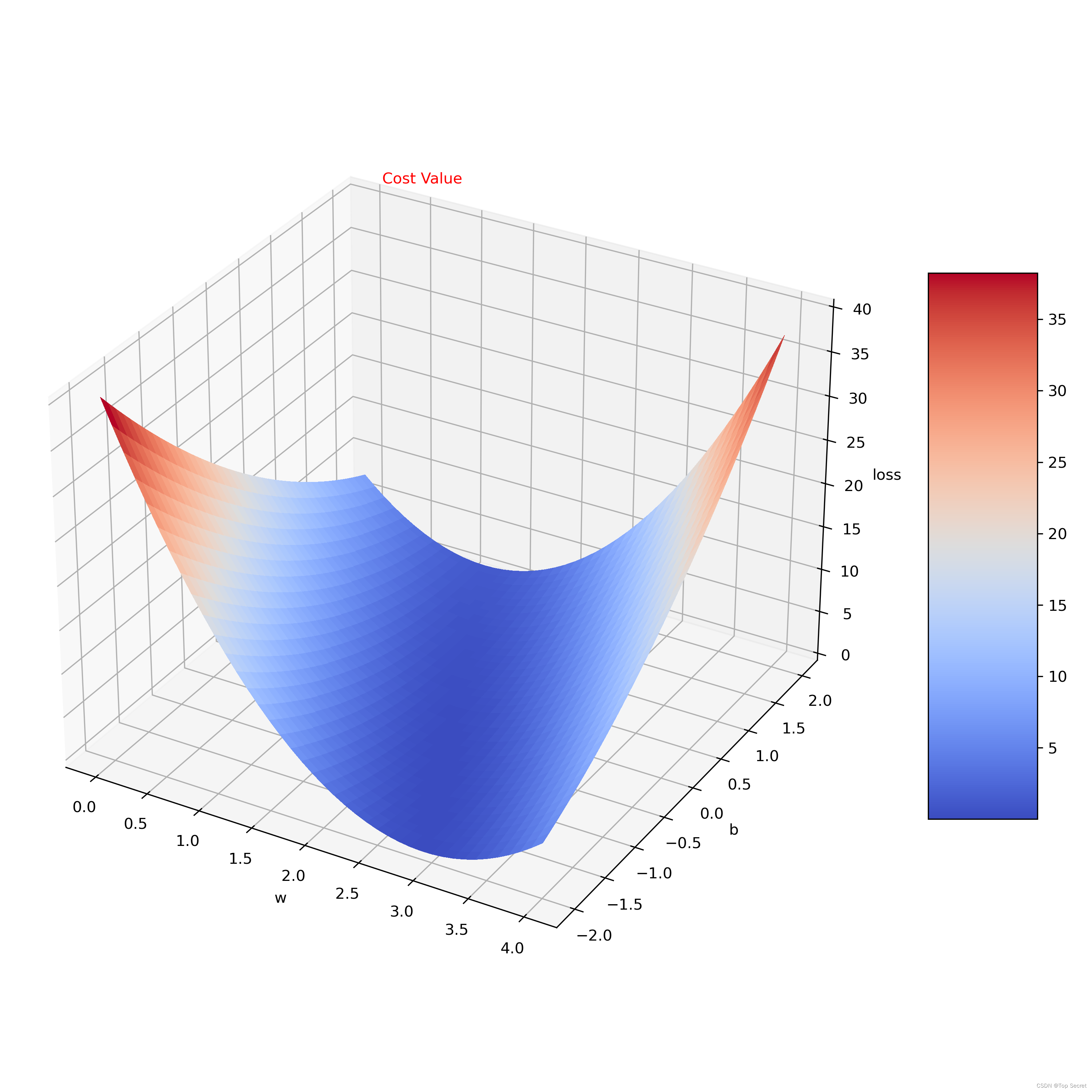
分析:此处代码的不同点在于第一个模型y=wx只需要更新参数w,而模型y=wx+b需要更新权重w和偏置b;还有需要注意的就是绘图时的差异。
1.1.3 对模型y = w*x 的代码实现(利用批量梯度下降)

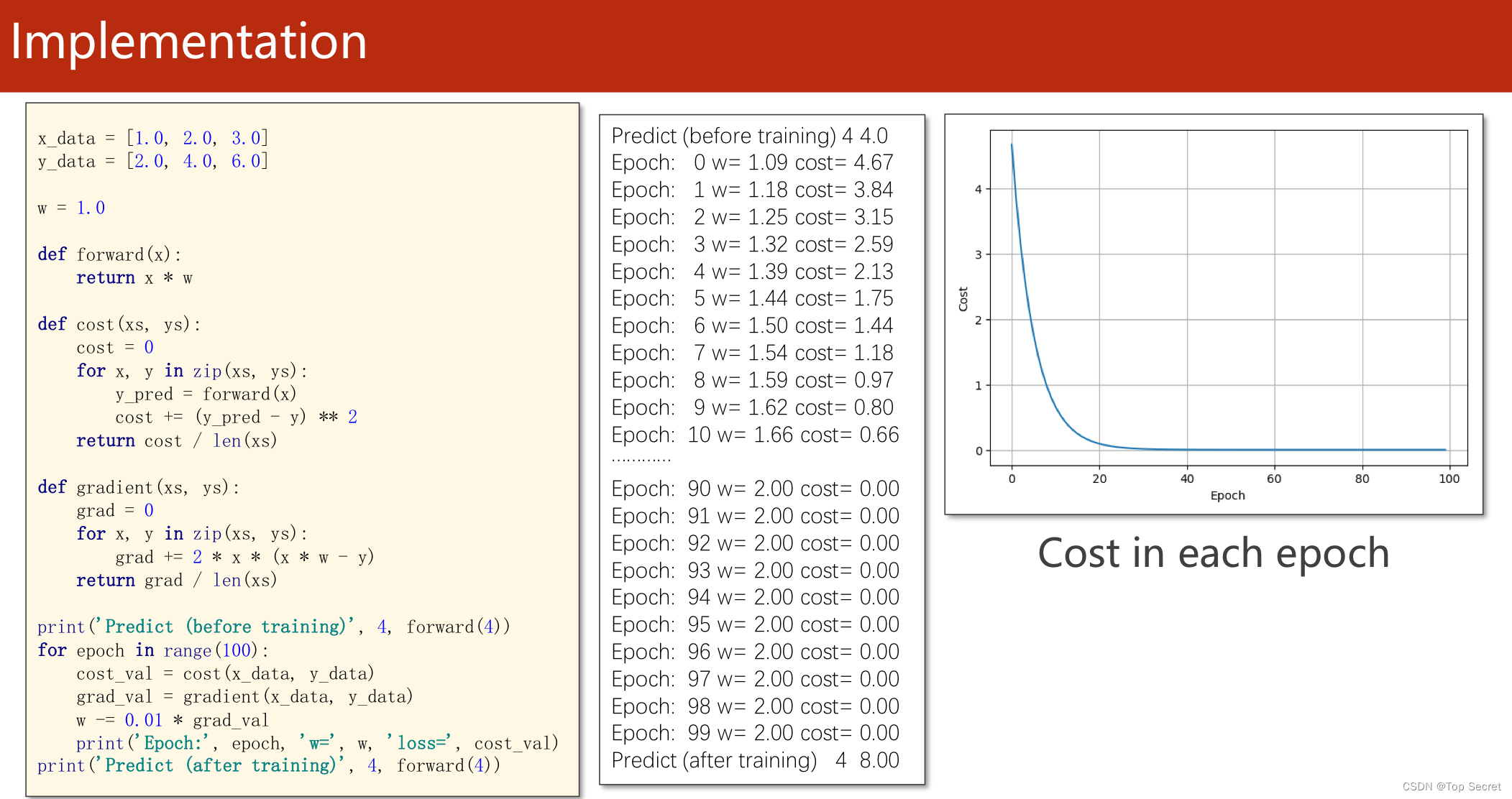
1.1.4 代码实现
import matplotlib.pyplot as plt
# prepare the training set
#准备数据集
x_data = [1.0, 2.0, 3.0]
y_data = [2.0, 4.0, 6.0]
# initial guess of weight
w = 1.0
# define the model linear model y = w*x
def forward(x):
return x * w
# define the cost function MSE
def cost(xs, ys):
cost = 0
for x, y in zip(xs, ys):
y_pred = forward(x)
cost += (y_pred - y) ** 2
return cost / len(xs)
# define the gradient function gd
def gradient(xs, ys):
grad = 0
for x, y in zip(xs, ys):
grad += 2 * x * (x * w - y)
return grad / len(xs)
epoch_list = []
cost_list = []
print('predict (before training)', 4, forward(4))
for epoch in range(100):
cost_val = cost(x_data, y_data) #caculate the sum of cost
grad_val = gradient(x_data, y_data) # caculate the gradient
w -= 0.01 * grad_val # 0.01 learning rate
print('epoch:', epoch, 'w=', w, 'loss=', cost_val)
#将每次训练更新的的损失存入列表中
epoch_list.append(epoch)
cost_list.append(cost_val)
print('predict (after training)', 4, forward(4))
plt.plot(epoch_list, cost_list)
plt.ylabel('cost')
plt.xlabel('epoch')
plt.show()
运行结果:
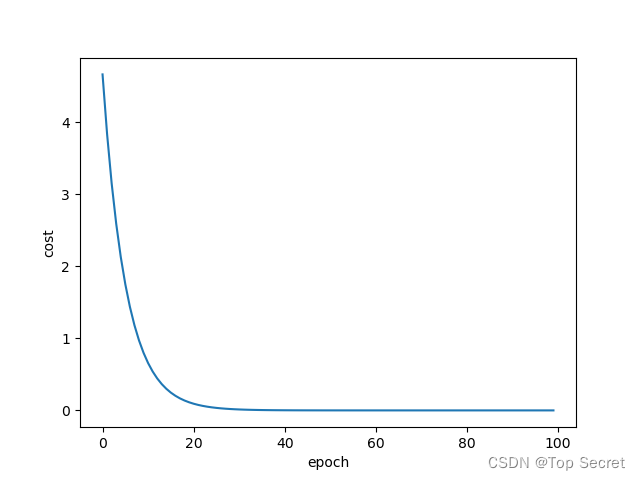
2.1 又一个线性回归的实例(学习于龙老师)
# 实现一个线性回归的问题 # y = wx + b
step1: 计算损失函数loss的值
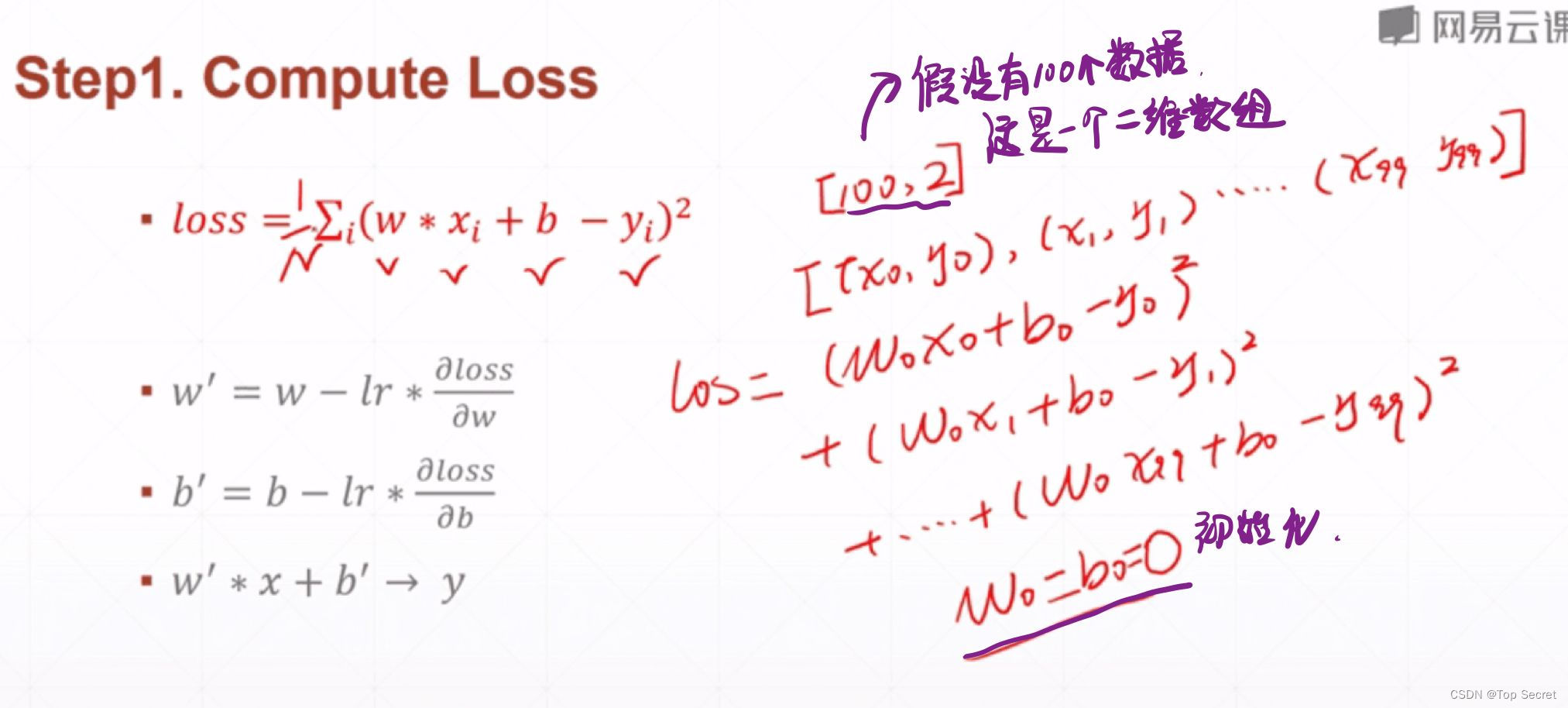
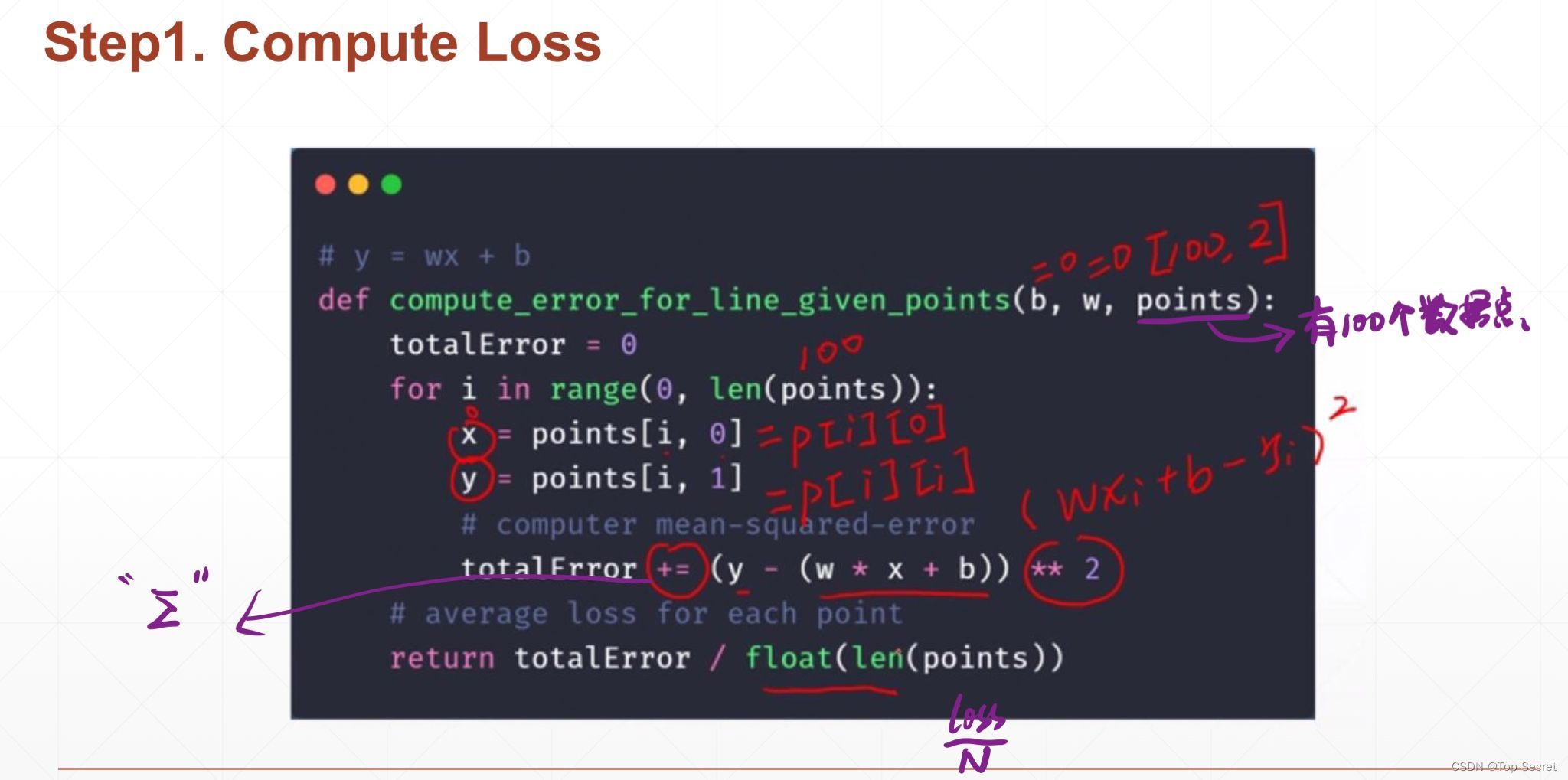
# 实现一个线性回归的问题
# y = wx + b
# step1: 计算损失函数loss的值
def compute_error_for_line_given_points(b, w, points): #points表示数据的数量
totalError = 0 #初始化损失函数的值
for i in range(0, len(points)):
x = points[i, 0]
y = points[i, 1]
# computer mean-squared-error
totalError += (y - (w * x + b)) ** 2 #求loss的累积和
# average loss for each point
return totalError / float(len(points))
step2:计算梯度与更新
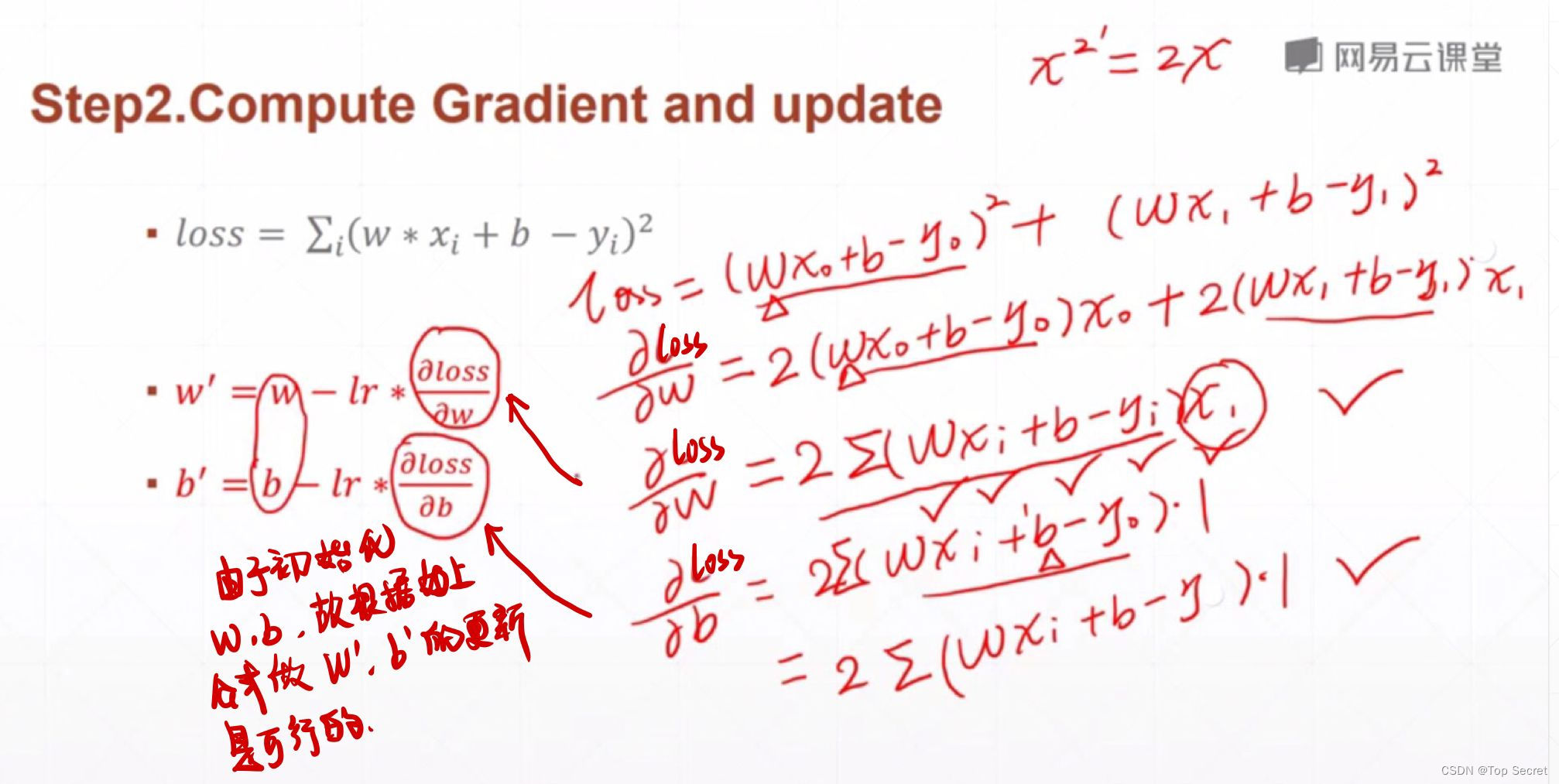
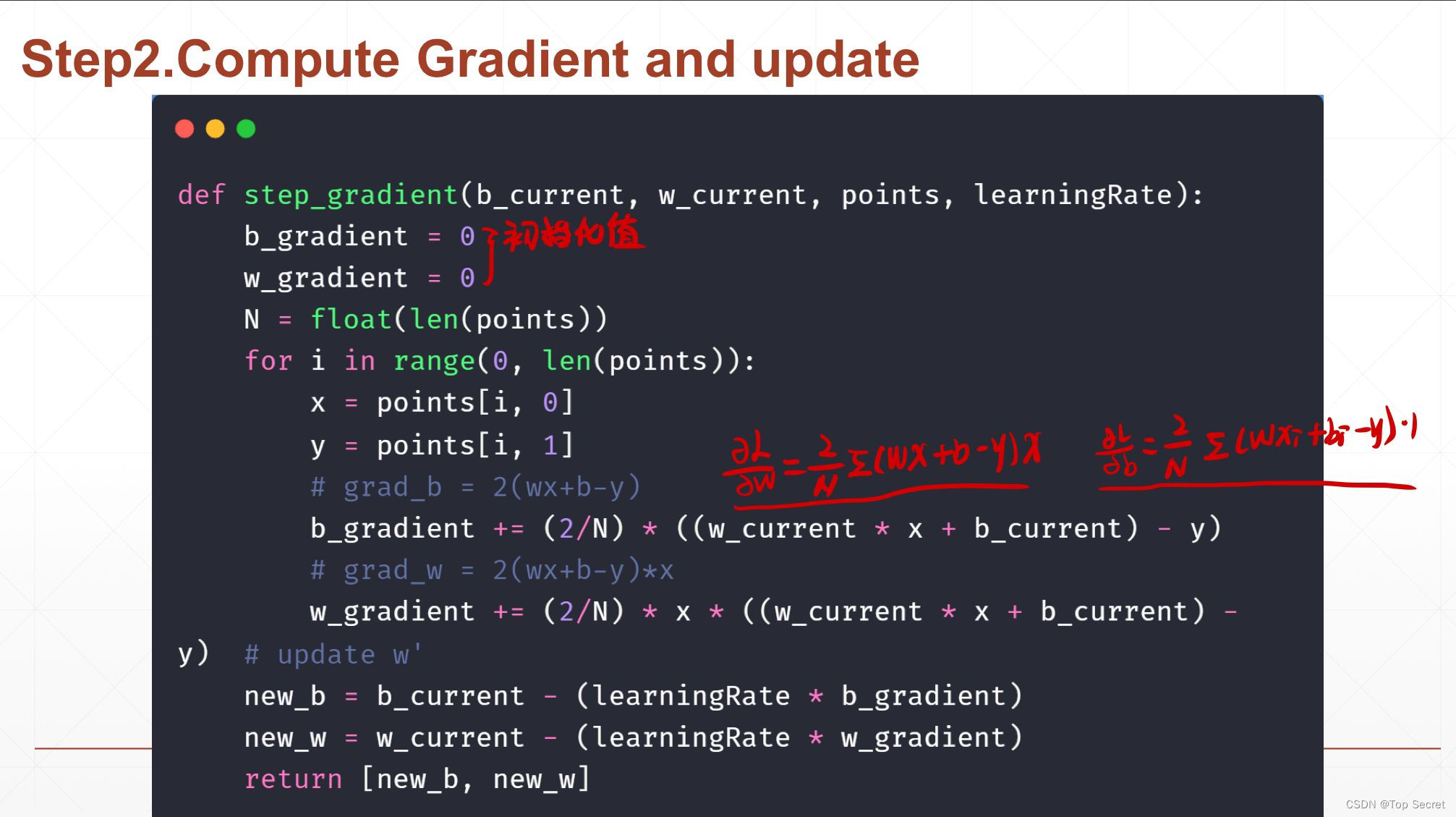
# step2:计算梯度与更新
def step_gradient(b_current, w_current, points, learningRate):
b_gradient = 0
w_gradient = 0
N = float(len(points))
for i in range(0, len(points)):
x = points[i, 0]
y = points[i, 1]
# grad_b = 2(wx+b-y)
b_gradient += (2/N) * ((w_current * x + b_current) - y)
# grad_w = 2(wx+b-y)*x
w_gradient += (2/N) * x * ((w_current * x + b_current) - y)
# update w'
new_b = b_current - (learningRate * b_gradient)
new_w = w_current - (learningRate * w_gradient)
return [new_b, new_w]
step3:更新权值w

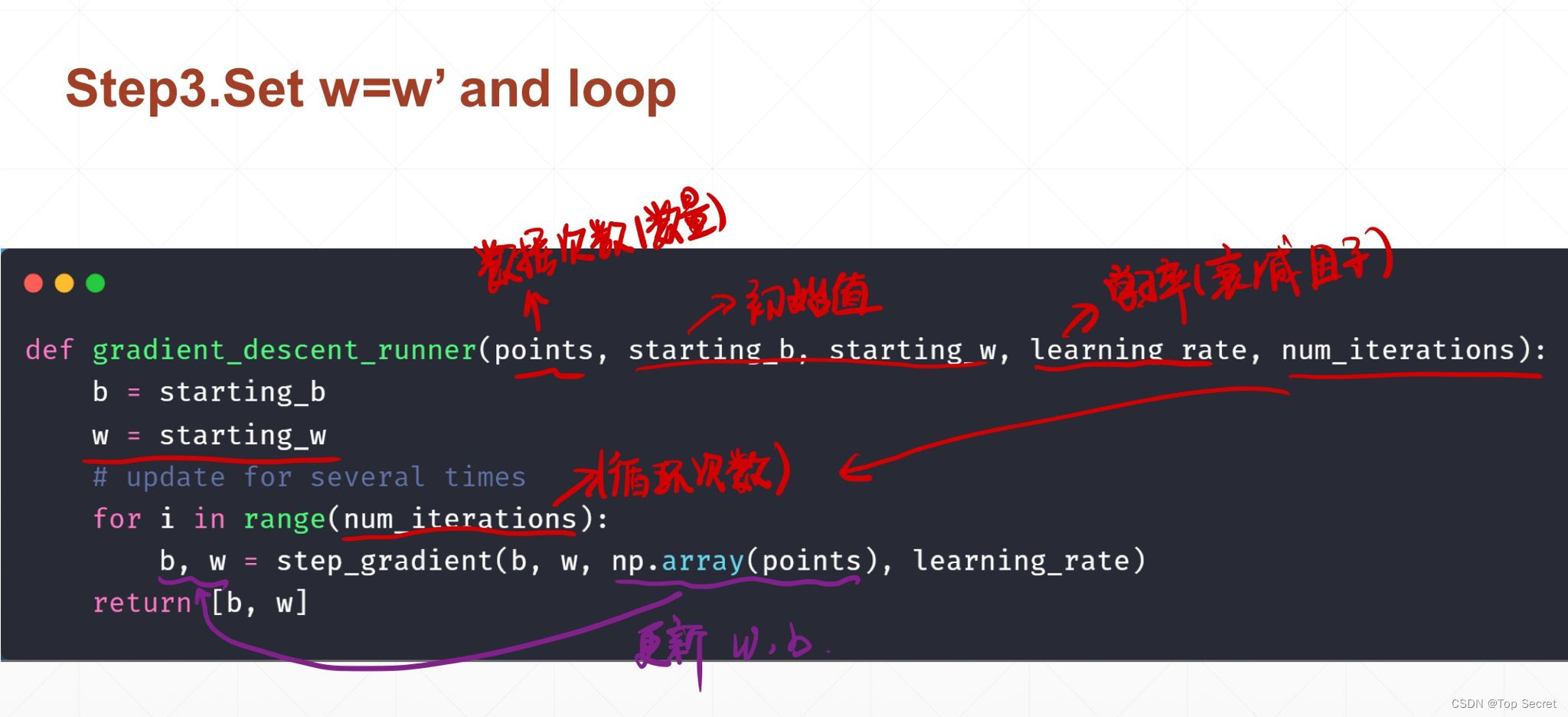
#更新权值w
def gradient_descent_runner(points, starting_b, starting_w, learning_rate, num_iterations):
b = starting_b
w = starting_w
# update for several times
for i in range(num_iterations):
b, w = step_gradient(b, w, np.array(points), learning_rate)
return [b, w]
step4:主函数
def run():
points = np.genfromtxt("data.csv", delimiter=",") #读取数据
learning_rate = 0.0001 #学习率
initial_b = 0 # initial y-intercept guess
initial_w = 0 # initial slope guess
num_iterations = 1000
print("Starting gradient descent at b = {0}, w = {1}, error = {2}"
.format(initial_b, initial_w,
compute_error_for_line_given_points(initial_b, initial_w, points))
)
print("Running...")
[b, w] = gradient_descent_runner(points, initial_b, initial_w, learning_rate, num_iterations)
print("After {0} iterations b = {1}, w = {2}, error = {3}".
format(num_iterations, b, w,
compute_error_for_line_given_points(b, w, points))
)
if __name__ == '__main__':
run()
2.1.1 线性回归问题的全部代码:
import numpy as np
# 实现一个线性回归的问题
# y = wx + b
# step1: 计算损失函数loss的值
def compute_error_for_line_given_points(b, w, points): #points表示数据的数量
totalError = 0 #初始化损失函数的值
for i in range(0, len(points)):
x = points[i, 0]
y = points[i, 1]
# computer mean-squared-error
totalError += (y - (w * x + b)) ** 2 #求loss的累积和
# average loss for each point
return totalError / float(len(points))
# step2:计算梯度与更新
def step_gradient(b_current, w_current, points, learningRate):
b_gradient = 0
w_gradient = 0
N = float(len(points))
for i in range(0, len(points)):
x = points[i, 0]
y = points[i, 1]
# grad_b = 2(wx+b-y)
b_gradient += (2/N) * ((w_current * x + b_current) - y)
# grad_w = 2(wx+b-y)*x
w_gradient += (2/N) * x * ((w_current * x + b_current) - y)
# update w'
new_b = b_current - (learningRate * b_gradient)
new_w = w_current - (learningRate * w_gradient)
return [new_b, new_w]
#更新权值w
def gradient_descent_runner(points, starting_b, starting_w, learning_rate, num_iterations):
b = starting_b
w = starting_w
# update for several times
for i in range(num_iterations):
b, w = step_gradient(b, w, np.array(points), learning_rate)
return [b, w]
def run():
points = np.genfromtxt("data.csv", delimiter=",") #读取数据
learning_rate = 0.0001 #学习率
initial_b = 0 # initial y-intercept guess
initial_w = 0 # initial slope guess
num_iterations = 1000
print("Starting gradient descent at b = {0}, w = {1}, error = {2}"
.format(initial_b, initial_w,
compute_error_for_line_given_points(initial_b, initial_w, points))
)
print("Running...")
[b, w] = gradient_descent_runner(points, initial_b, initial_w, learning_rate, num_iterations)
print("After {0} iterations b = {1}, w = {2}, error = {3}".
format(num_iterations, b, w,
compute_error_for_line_given_points(b, w, points))
)
if __name__ == '__main__':
run()

2. torch实现线性回归模型
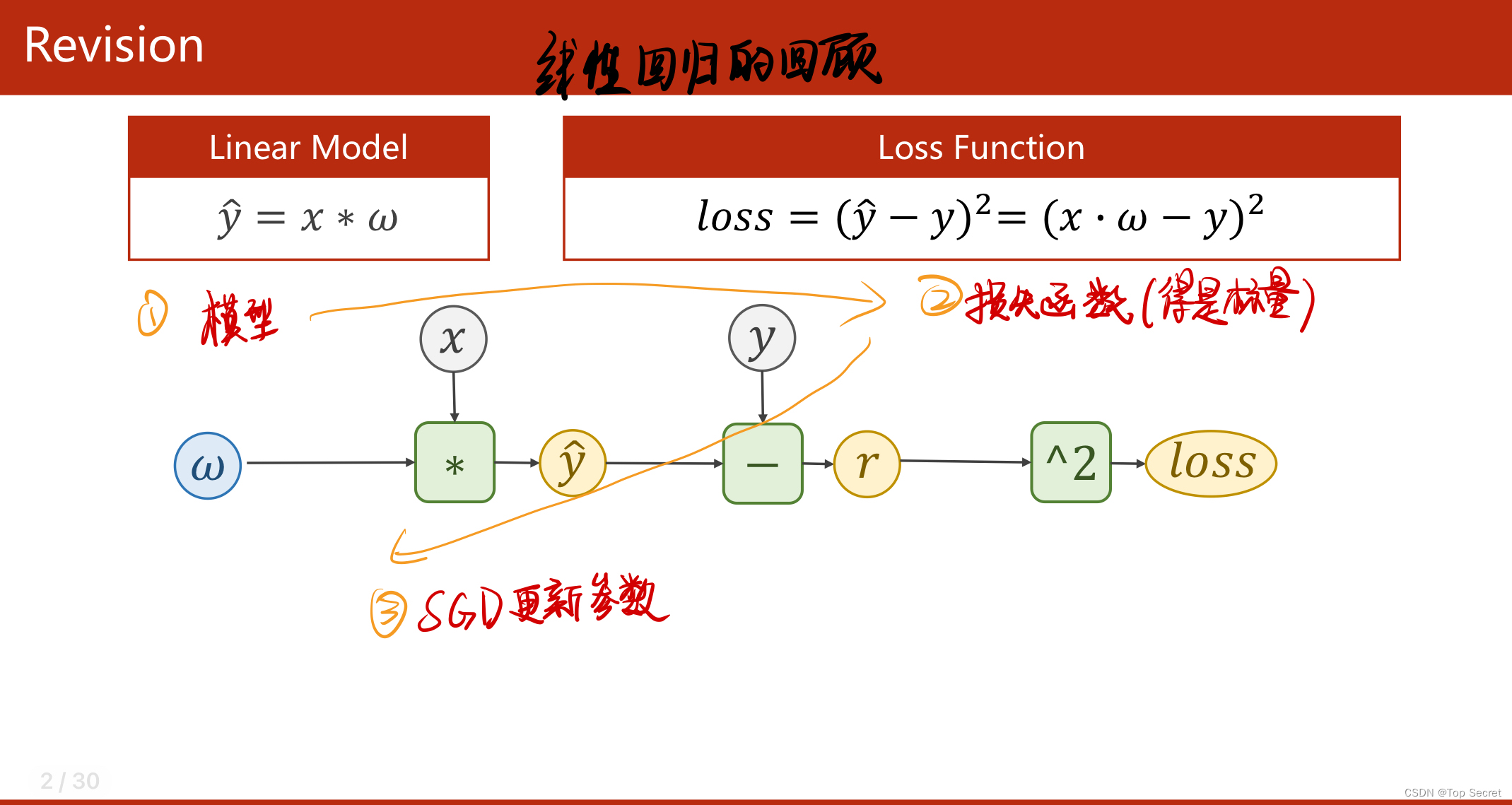
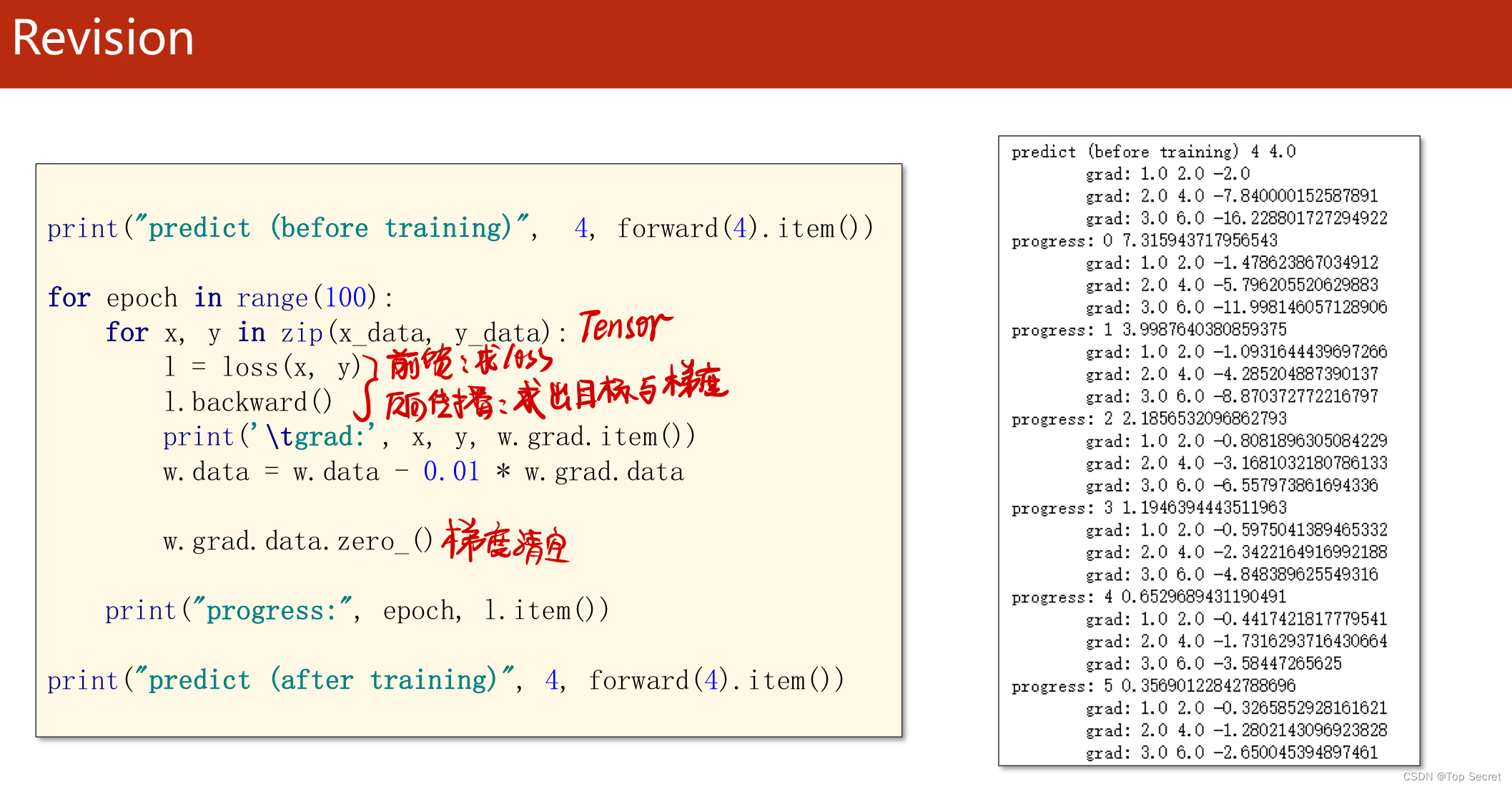
2.1 pytorch构建神经网络的基本步骤
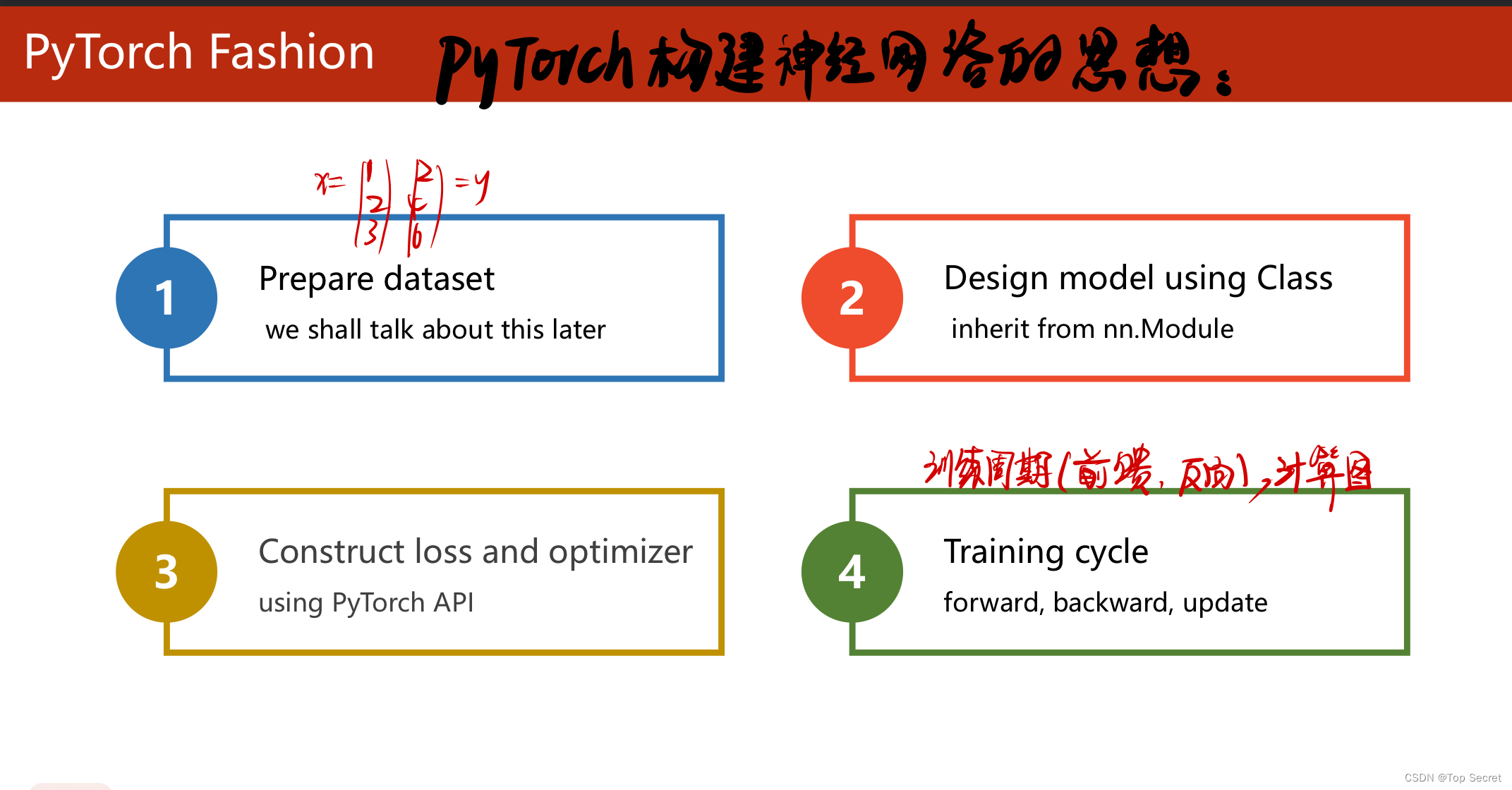
step1:数据集的准备
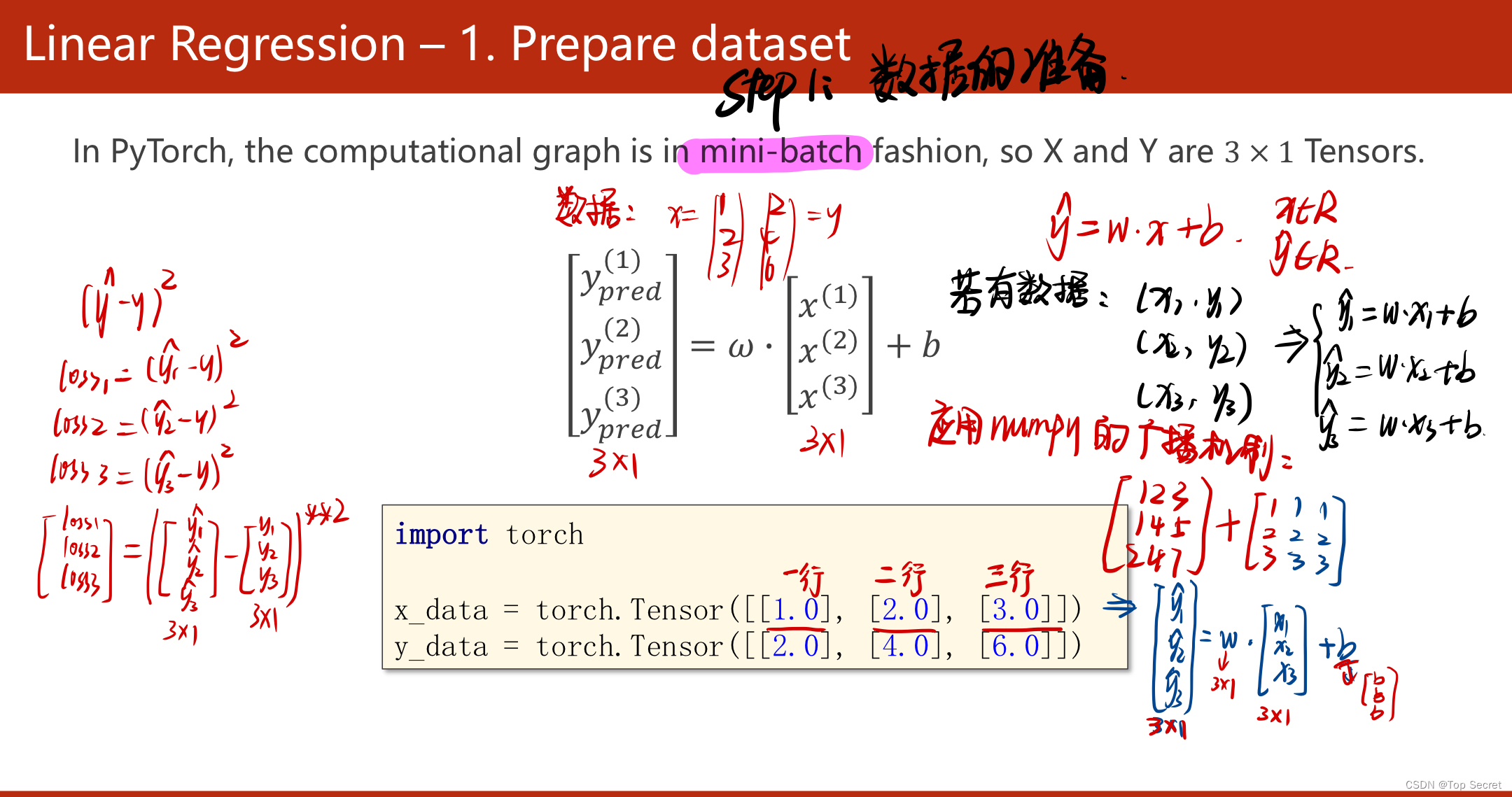
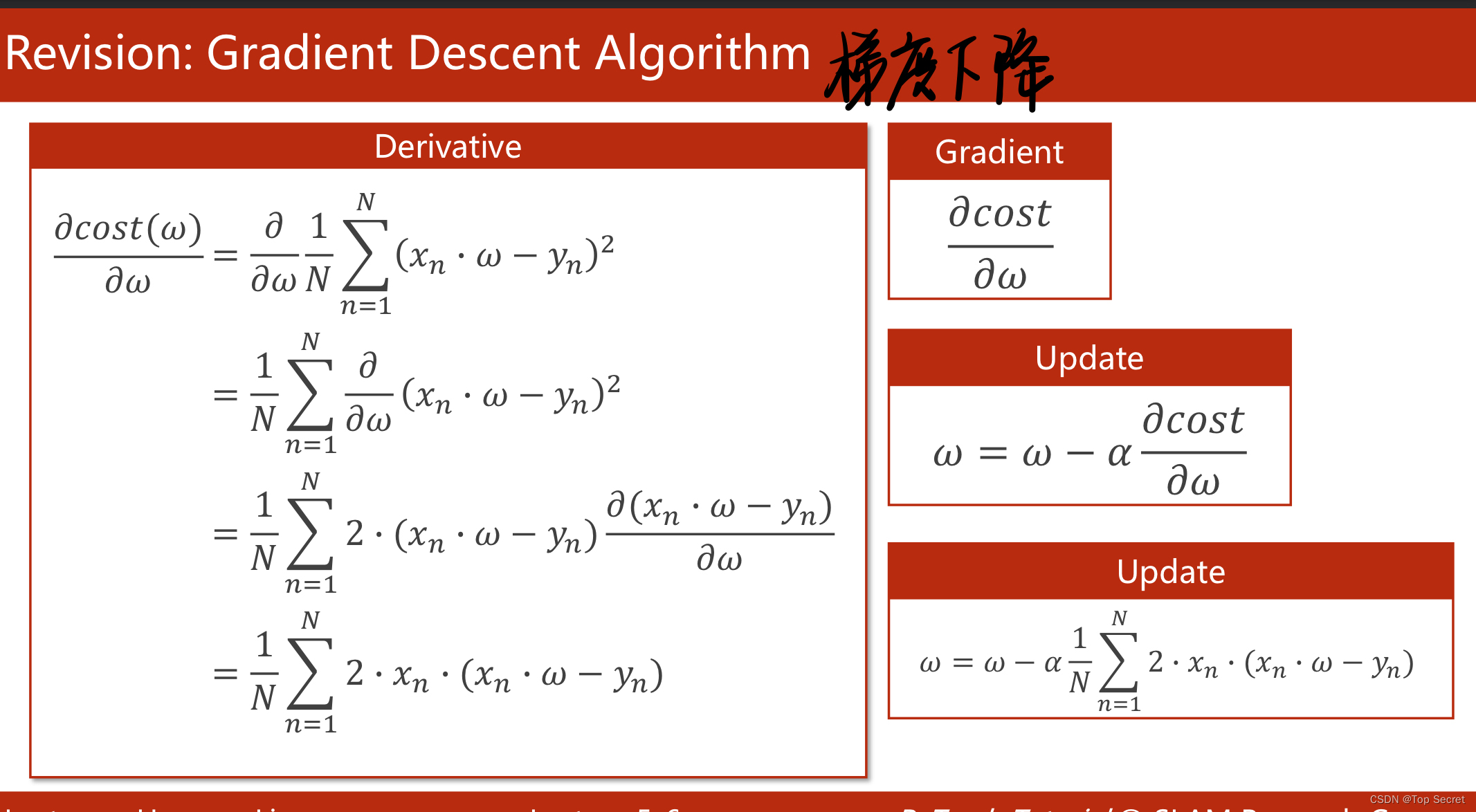
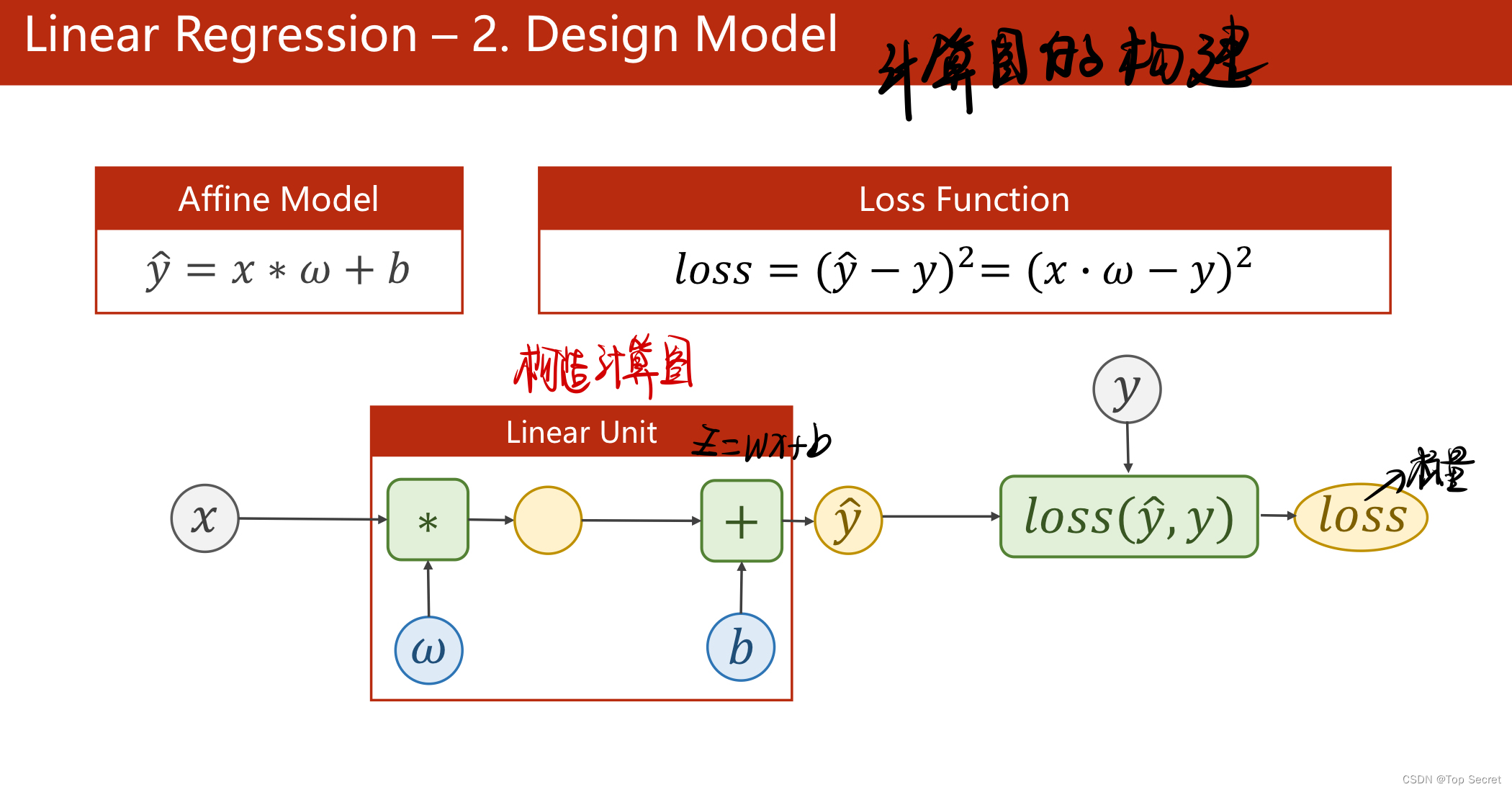
step2:构建数学模型

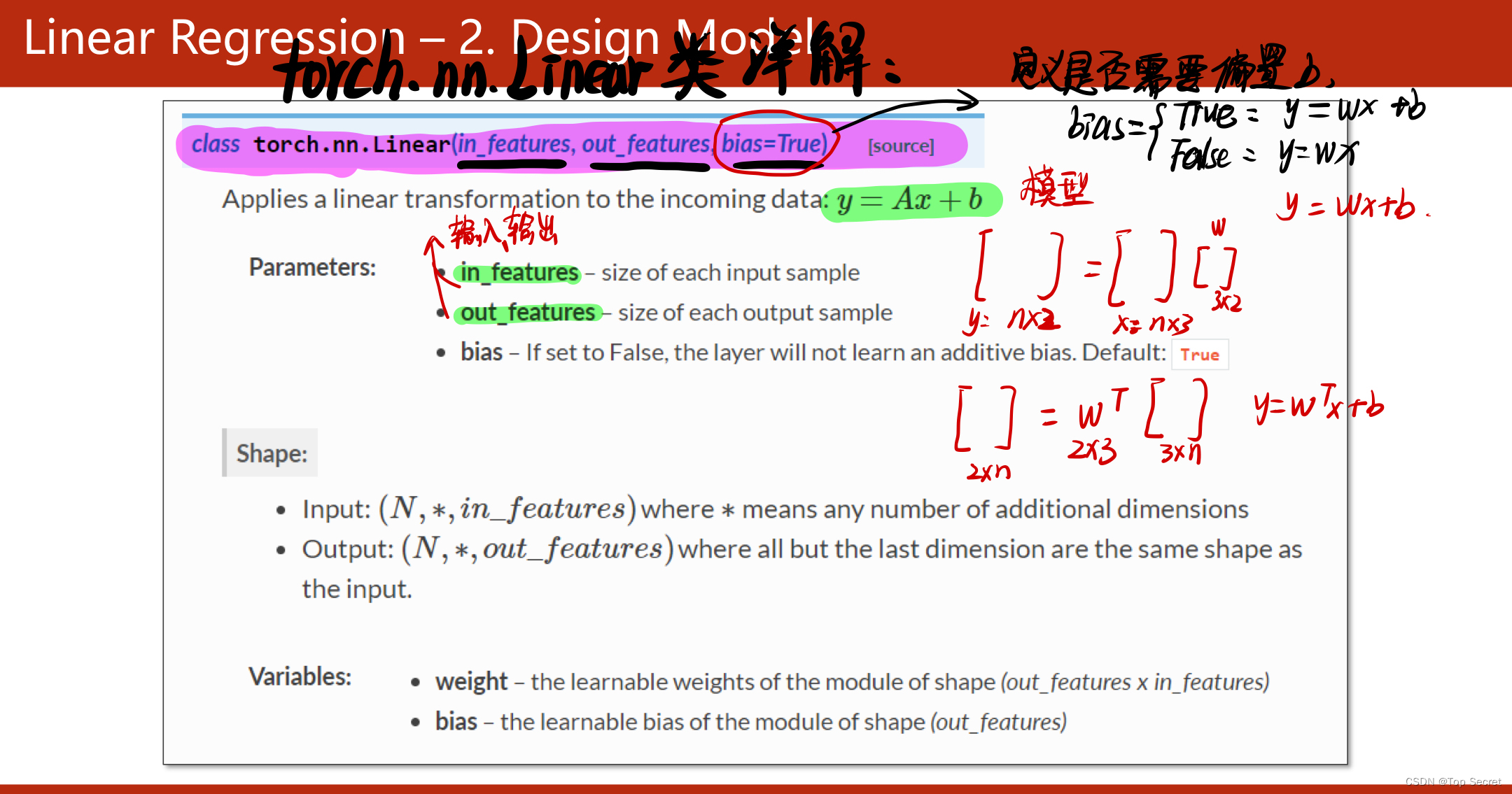
torch.nn.Linear类
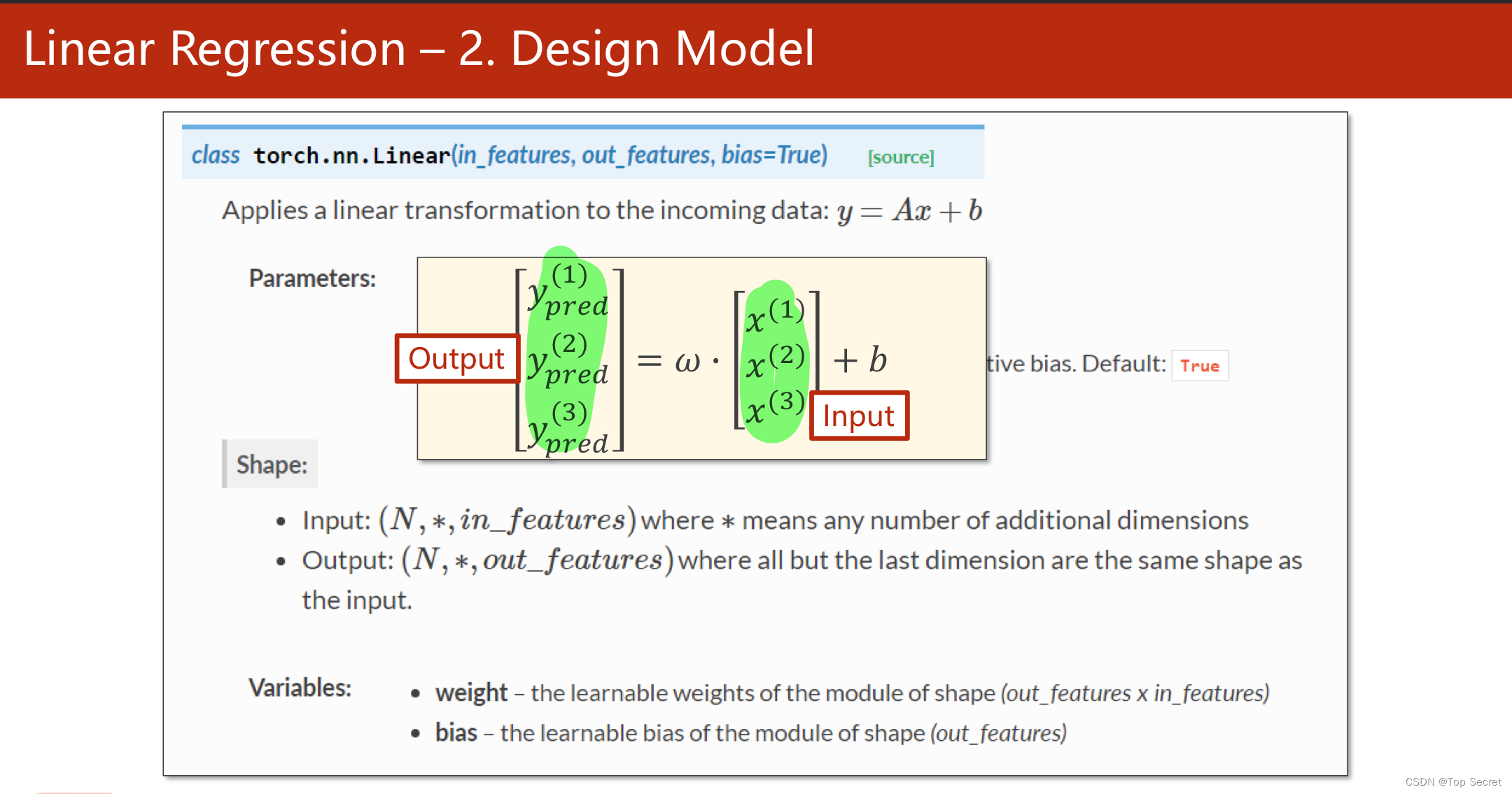

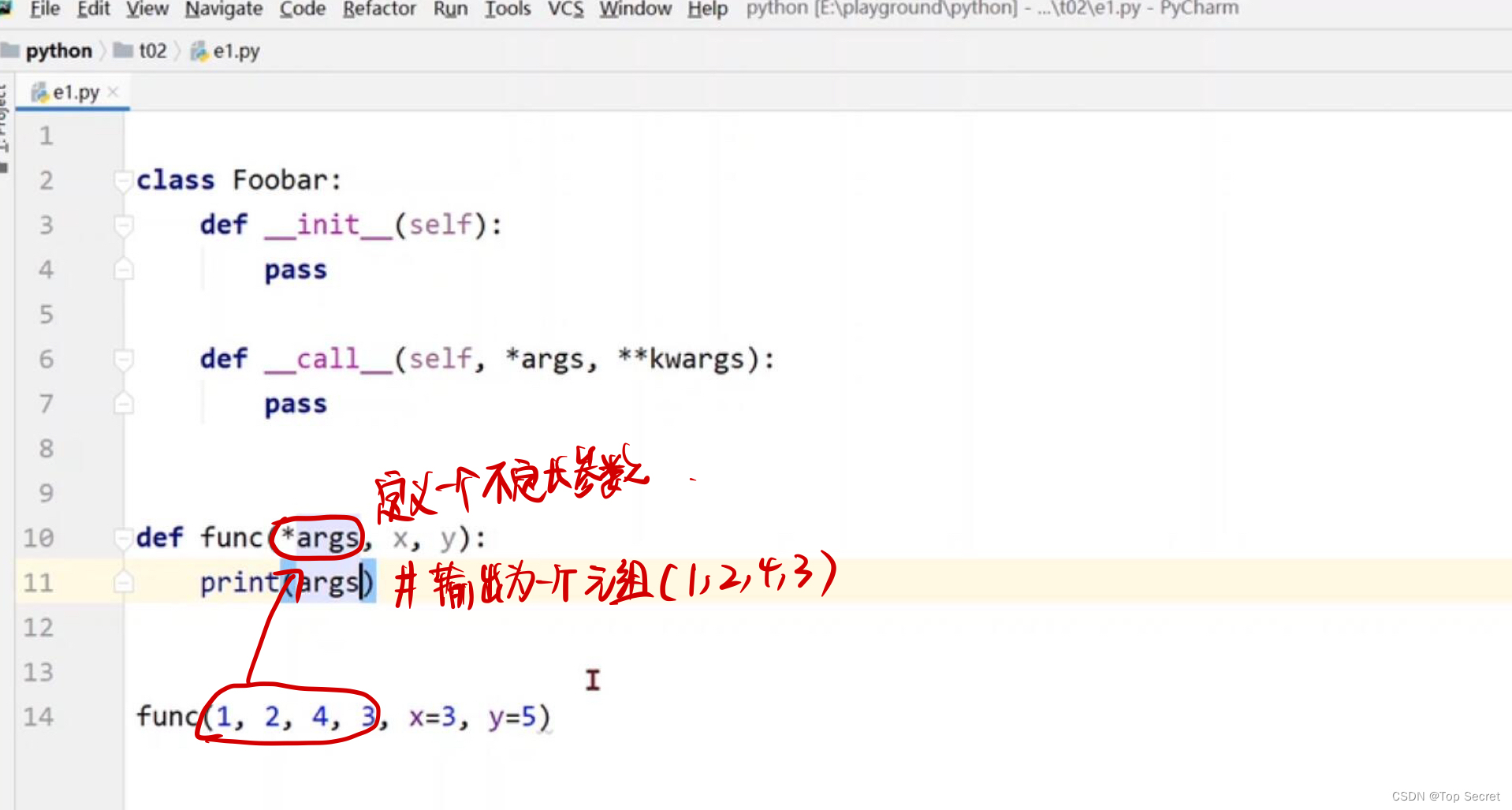
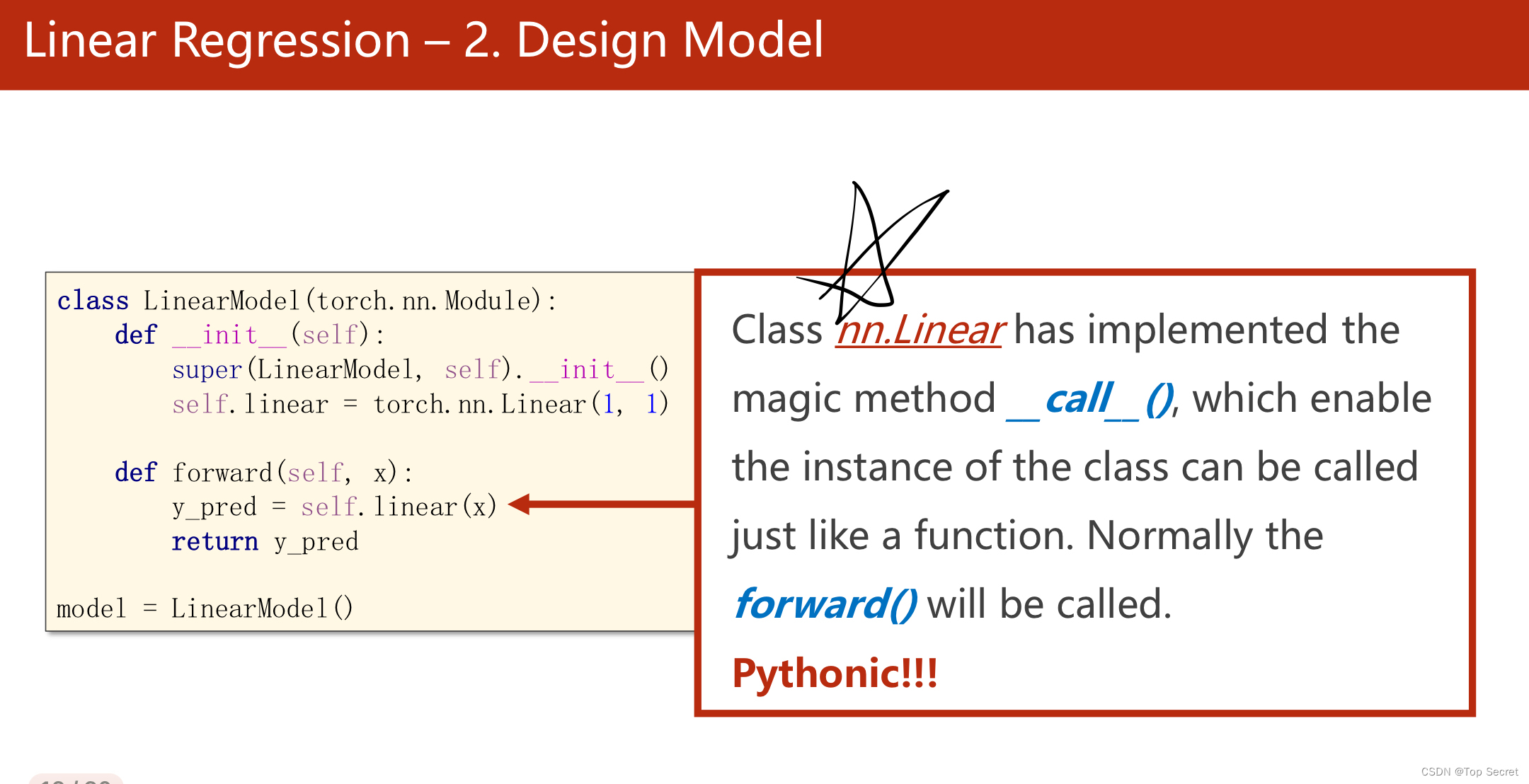
step3:构造损失函数与优化器
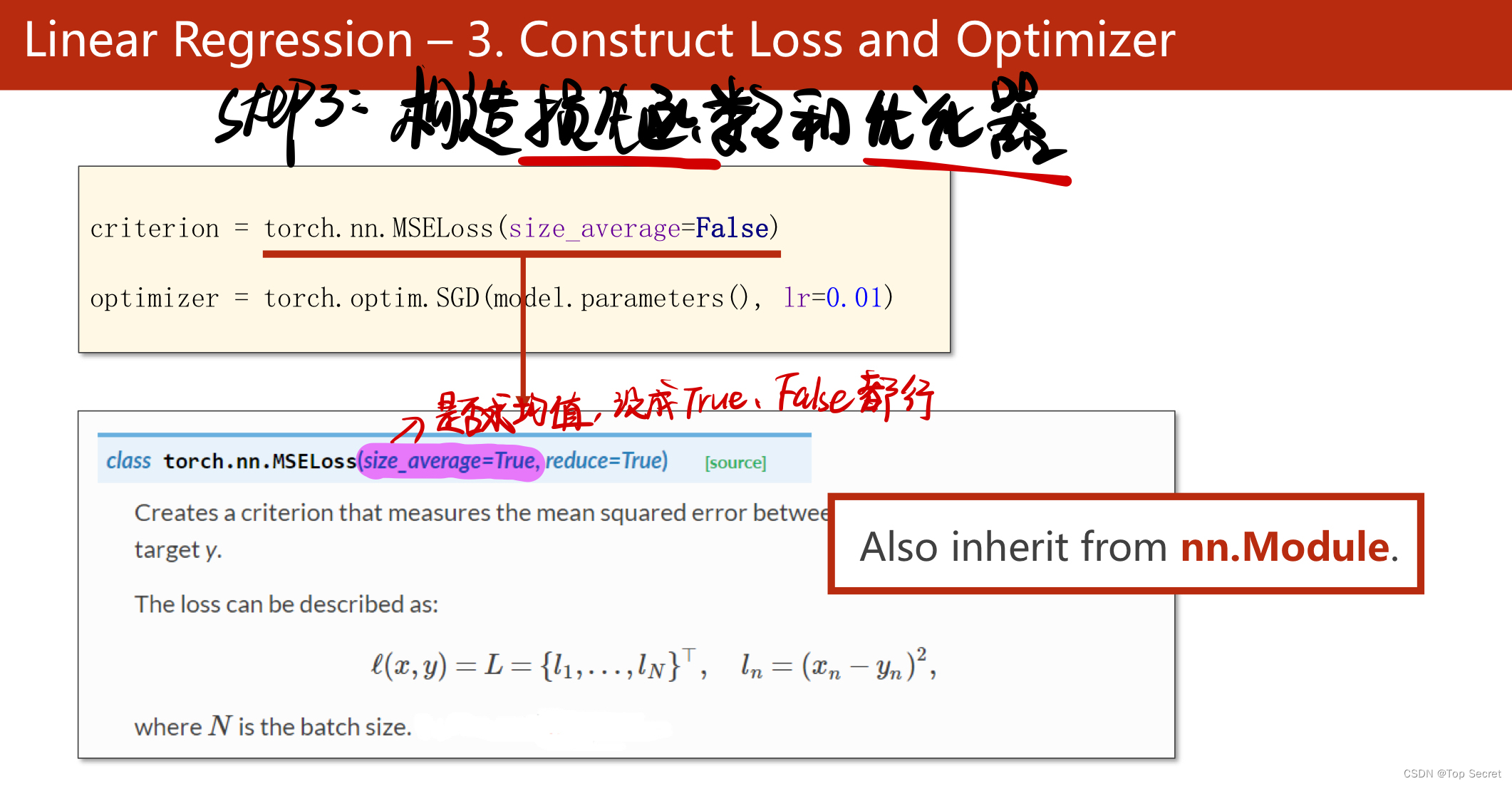
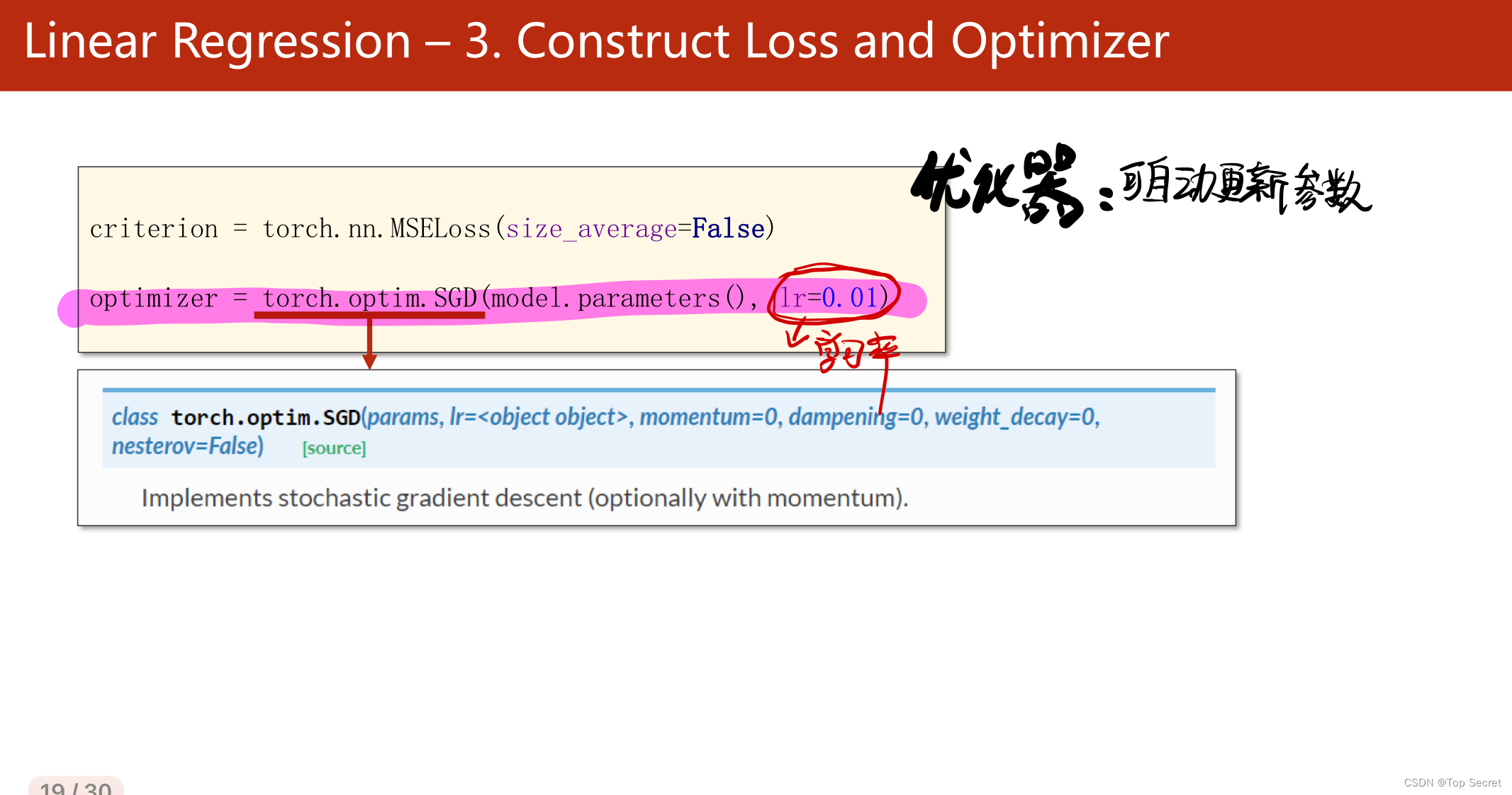
作业:

step4:训练模型
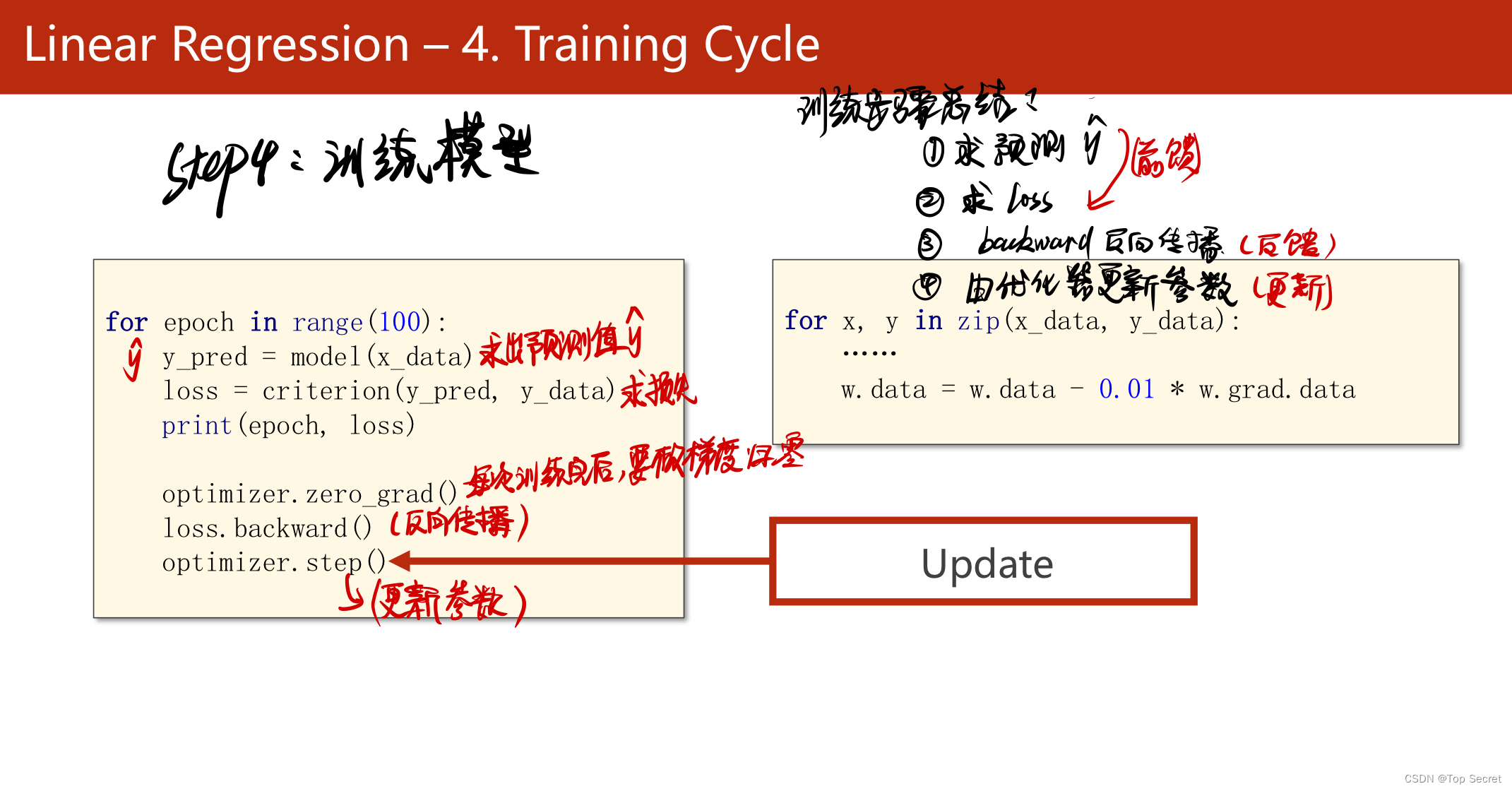
step5:训练测试集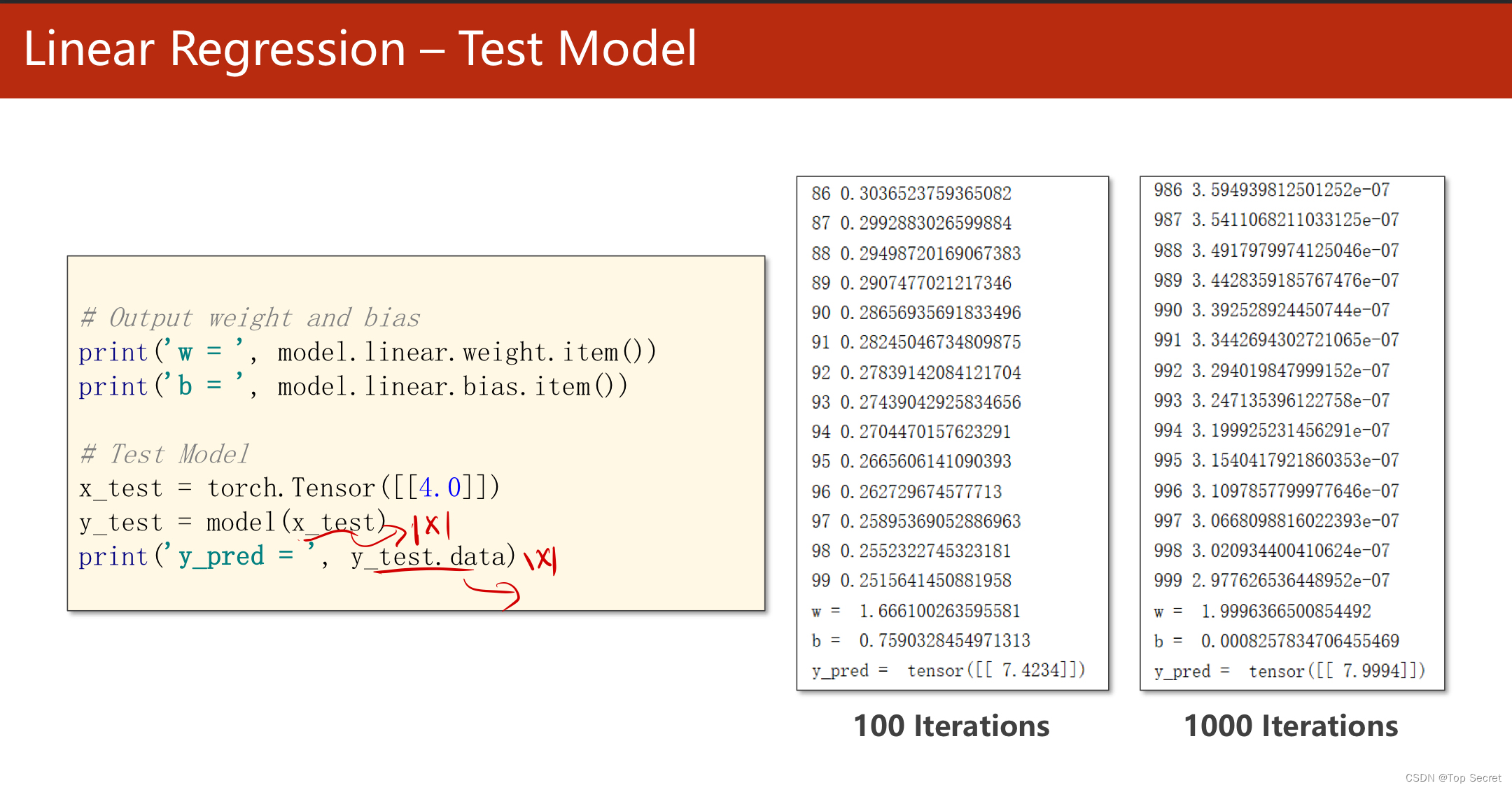
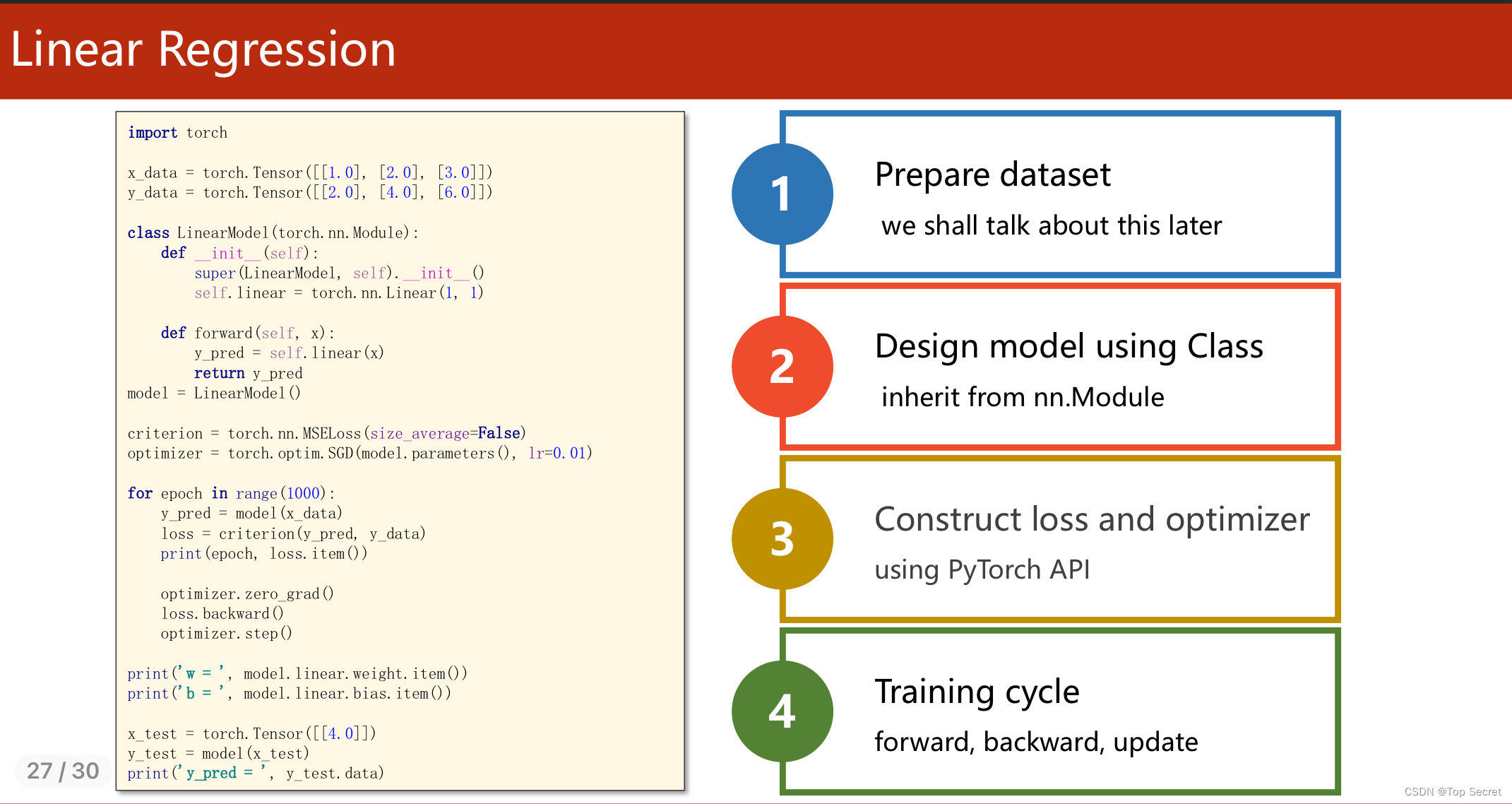
网址:Learning PyTorch with Examples — PyTorch Tutorials 1.12.1+cu102 documentation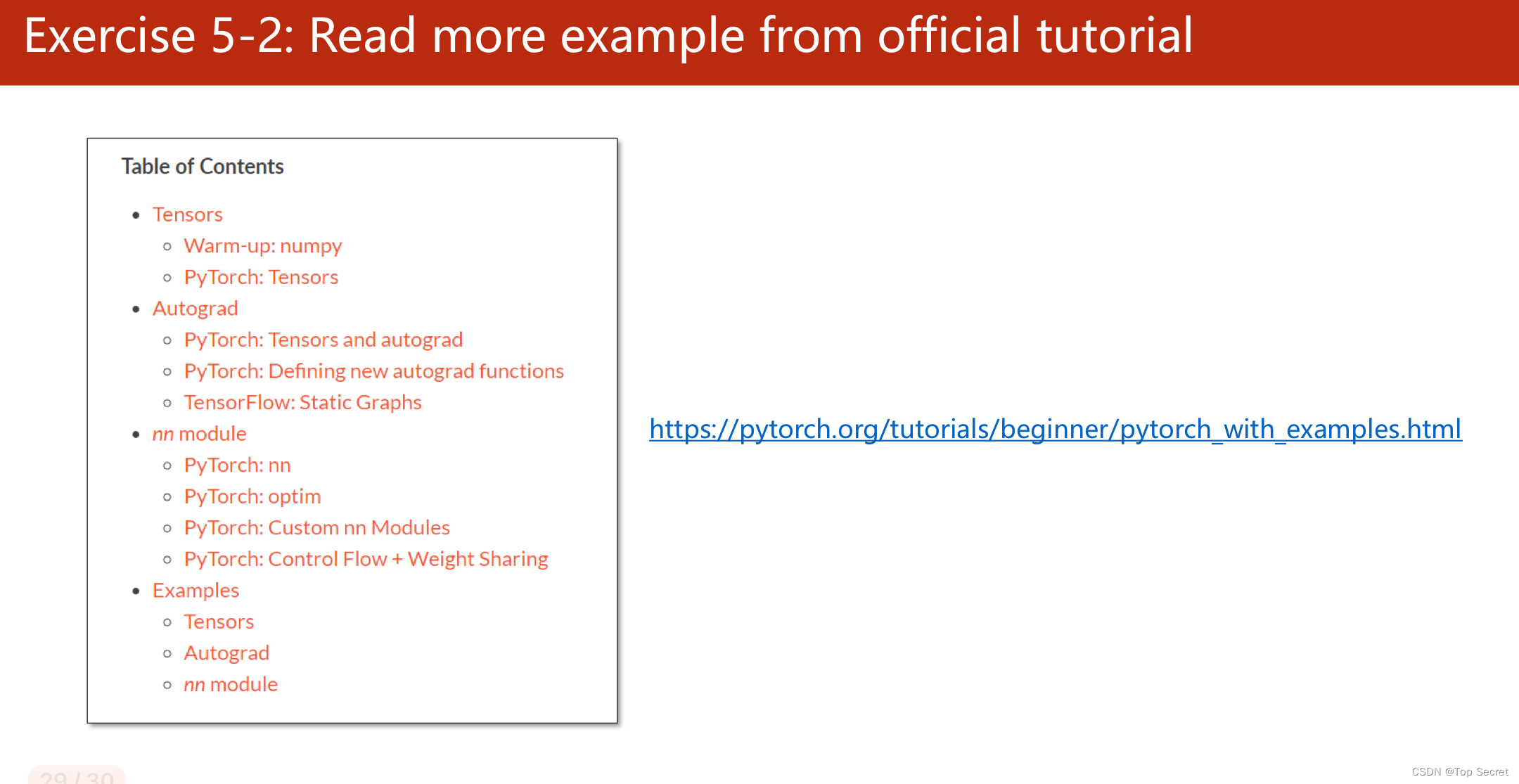
2.2 pytorch代码
实现前后,可以对比一下此文中的内容:
PyTorch 深度学习实践 第5讲_错错莫的博客-CSDN博客
import torch
#step1:prepare dataset
x_data = torch.Tensor([[1.0],[2.0],[3.0]]) #一共三行数据
y_data = torch.Tensor([[2.0],[4.0],[6.0]])
#step2:定义模型(以线性模型为例)
class LinearModel(torch.nn.Module): #构建自己的数学模型需要继承torch的torch.nn.Module类
def __init__(self): #构造函数,用于初始化对象
super(LinearModel, self).__init__()
# torch.nn.Linear() 也是torch的一个类,此处相当于实例化一个对象,传入的参数为权重w和偏置b
self.linear = torch.nn.Linear(1,1)
#该函数即数学模型的直接实现,返回求得的预测值
def forward(self,x):
y_pred = self.linear(x)
return y_pred
model = LinearModel()
#step3:构造损失函数和优化器
criterion = torch.nn.MSELoss(size_average=False) #选用均方差损失
optimizer = torch.optim.SGD(model.parameters(),lr=0.01) # 优化器,用于自动更新参数
if __name__ == '__main__':
#step4:训练模型
for epoch in range(100): #将所有数据训练100次
y_pred = model(x_data) #求得预测值
loss = criterion(y_pred,y_data) #求损失函数
print("当前训练epoch为:",epoch,"损失函数loss值为:",loss)
optimizer.zero_grad() #梯度清理
loss.backward() #反向传播
optimizer.step() #更新参数
#打印更新的权值w和偏置b
print('w =',model.linear.weight.item())
print('b =', model.linear.bias.item())
#训练测试集
x_test = torch.Tensor([[4.0]])
y_test = model(x_test)
print('y_pred = ',y_test.data)
结果:
2.3 代码2(和1其实一样,注释不一样而已)
import torch
# prepare dataset
# x,y是矩阵,3行1列 也就是说总共有3个数据,每个数据只有1个特征
x_data = torch.tensor([[1.0], [2.0], [3.0]])
y_data = torch.tensor([[2.0], [4.0], [6.0]])
# design model using class
"""
our model class should be inherit from nn.Module, which is base class for all neural network modules.
member methods __init__() and forward() have to be implemented
class nn.linear contain two member Tensors: weight and bias
class nn.Linear has implemented the magic method __call__(),which enable the instance of the class can
be called just like a function.Normally the forward() will be called
"""
class LinearModel(torch.nn.Module):
def __init__(self):
super(LinearModel, self).__init__()
# (1,1)是指输入x和输出y的特征维度,这里数据集中的x和y的特征都是1维的
# 该线性层需要学习的参数是w和b 获取w/b的方式分别是~linear.weight/linear.bias
self.linear = torch.nn.Linear(1, 1)
def forward(self, x):
y_pred = self.linear(x)
return y_pred
model = LinearModel()
# construct loss and optimizer
# criterion = torch.nn.MSELoss(size_average = False)
criterion = torch.nn.MSELoss(reduction='sum')
optimizer = torch.optim.SGD(model.parameters(), lr=0.01) # model.parameters()自动完成参数的初始化操作
# training cycle forward, backward, update
for epoch in range(100):
y_pred = model(x_data) # forward:predict
loss = criterion(y_pred, y_data) # forward: loss
print(epoch, loss.item())
optimizer.zero_grad() # the grad computer by .backward() will be accumulated. so before backward, remember set the grad to zero
loss.backward() # backward: autograd,自动计算梯度
optimizer.step() # update 参数,即更新w和b的值
print('w = ', model.linear.weight.item())
print('b = ', model.linear.bias.item())
x_test = torch.tensor([[4.0]])
y_test = model(x_test)
print('y_pred = ', y_test.data)
结果:
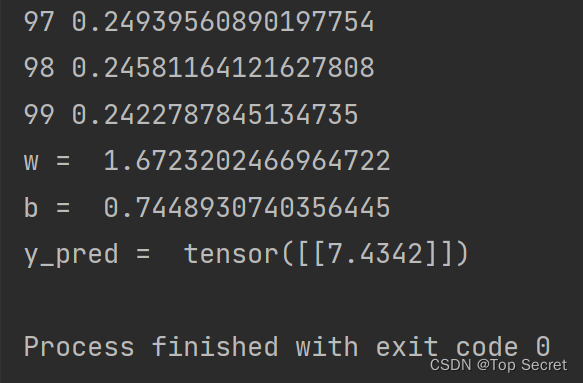
版权归原作者 Top Secret 所有, 如有侵权,请联系我们删除。